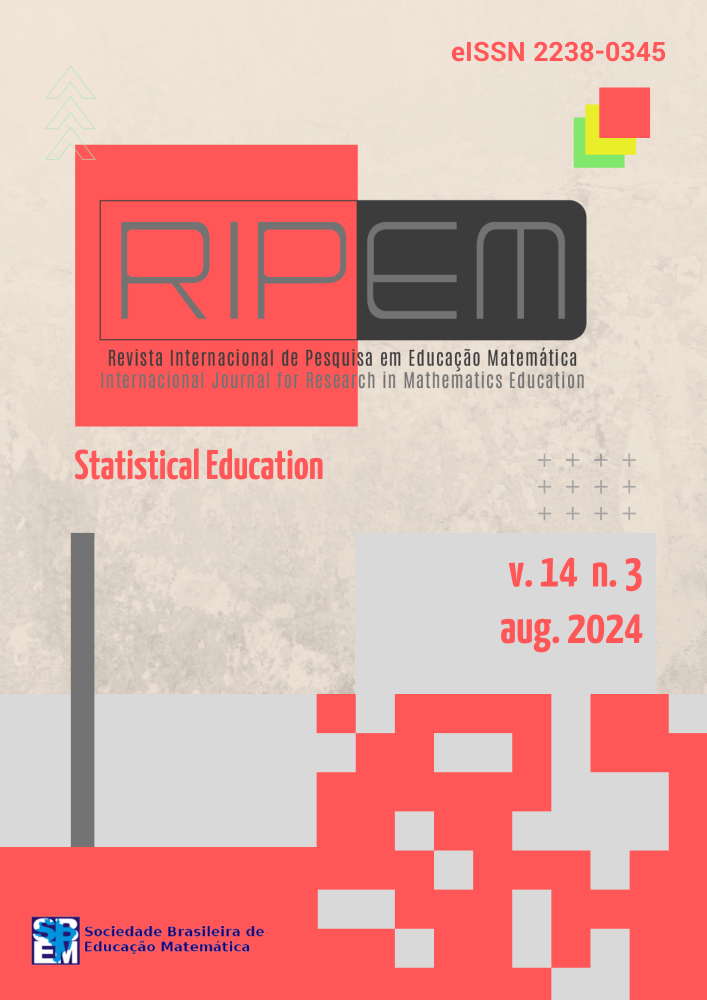Opciones tecnológicas en Estadística: reflexiones sobre las prácticas pedagógicas en el contexto universitario brasileño
DOI:
https://doi.org/10.37001/ripem.v14i3.3805Palabras clave:
Educación Estadística, Tecnologías Digitales, Formación de Profesores, Literacia Estadística, TPACKResumen
Neste artículo analizamos la integración de las tecnologías digitales en la enseñanza de la estadística, explorando las percepciones y prácticas de los docentes en el contexto brasileño. Investigamos las elecciones tecnológicas de los educadores a través de técnicas estadísticas descriptivas y análisis multivariado, destacando la relación entre la formación docente, las prácticas pedagógicas y el uso de tecnologías digitales. Como resultados, identificamos la influencia de la formación de los docentes en sus elecciones tecnológicas y discutimos los resultados a la luz de la Literacia Estadística y el modelo TPACK. El estudio ofrece consideraciones sobre el papel crucial de la formación docente en la integración crítica e intencional de la tecnología, proporcionando reflexiones valiosas para la educación estadística contemporánea en el escenario universitario brasileño.
Descargas
Citas
Ainley, J.; Gould, R. & Pratt, D. (2015). Learning to reason from samples: Commentary from the perspectives of task design and the emergence of “big data”. Educational Studies in Mathematics, 88(3), 405-412.
American Statistical Association. (2014). Curriculum Guidelines for Undergraduate Programs in Statistical Science. Alexandria, VA.
Batanero, C. (2000). ¿Hacia Dónde Va La Educación Estadística? Blaix, 15, 2-13.
Batanero, C. (2019). Thirty years of stochastics education research: Reflections and challenges. In: Tercer Congreso Internacional Virtual de Educación Estadística (pp. 1-15). Granada, Spain.
Ben-Zvi, D.; Gravemeijer, K. & Ainley, J. (2019). Design of statistics learning environments. In: Eleventh Congress of the European Society for Research in Mathematics Education (CERME11) (pp. 1-10). Utrecht, Netherlands.
Bertoncelo, E. R. E. (2022). Construindo espaços relacionais com a análise de correspondências múltiplas: aplicações nas ciências sociais. Brasília, DF: ENAP.
Biehler, R. (1990). Changing conceptions of statistics: A problem area for teacher education. In: International Statistical Institute Round Table Conference (pp. 20-38). Voorburg.
Carver, R.; Everson, M.; Gabrosek, J.; Horton, N.; Lock, R.; Mocko, M.; Rossman, A.; Roswell, G.; Velleman, P.; Witmer, J. & Wood, B. (2016). Guidelines for Assessment and Instruction in Statistics Education (GAISE) College Report 2016.
Filatro, A. & Cavalcanti, C. C. (2018). Metodologias Inov-Ativas na educação presencial, a distância e corporativa. São Paulo, SP: Saraiva Uni.
Freitas, M. T. (2010). Letramento digital e formação de professores. Educação em Revista, 26, 335-352.
Gal, I. (2002). Adults’ Statistical Literacy: Meanings, Components, Responsibilities. International Statistical Review / Revue Internationale de Statistique, 70(1), 1-25.
Gal, I. (2019). Understanding statistical literacy: About knowledge of contexts and models. In: Tercer Congreso Internacional Virtual de Educación Estadística (pp. 1-15). Granada, Spain.
Garfield, J. B.; Ben-Zvi, D.; Chance, B.; Medina, E.; Roseth, C. & Zieffler, A. (2008). Developing Students’ Statistical Reasoning. Dordrecht: Springer.
Gomes, E. G. S.; André, R. C. M. & Morais, M. D. (2023). O uso de tecnologias digitais da informação e comunicação fomentando o letramento matemático na formação de professores de Matemática dos Anos Iniciais. Revista Internacional de Pesquisa em Educação Matemática, 13(1), 1-20.
Gomes, E. G. S. & Carvalho, A. B. (2020). As estratégias dos docentes com o uso de tecnologias digitais no contexto pandêmico da Covid-19. Em Teia, 11(2), 1-18.
Gould, R. (2012). Preface To The Proceedings Of The 2012 Iase Roundtable On Technology And Statistics Education. In: Technology in Statistics Education: Virtualities and Realities (pp. 1-3). Cebu.
Gould, R. (2021). Toward data-scientific thinking. Teaching Statistics, 43(S1), 11-22.
Hastie, T.; Friedman, J. & Tibshirani, R. (2001). The Elements of Statistical Learning. New York: Springer.
Husson, F.; Le, S. & Pagès, J. (2017). Exploratory Multivariate Analysis by Example Using R. London, UK: CRC Press.
Koehler, M. & Mishra, P. (2009). What is Technological Pedagogical Content Knowledge (TPACK)? Contemporary Issues in Technology and Teacher Education, 9(1), 60-70.
Lankshear, C. & Knobel, M. (2008). Digital Literacies: Concepts, Policies and Practices (v. 30). New York, NY: Peter Lang.
Lê, S.; Josse, J. & Husson, F. (2008). FactoMineR: An R Package for Multivariate Analysis. Journal of Statistical Software, 25, 1-18.
List, A.; Brante, E. W. & Klee, H. L. (2020). A framework of pre-service teachers’ conceptions about digital literacy: Comparing the United States and Sweden. Computers & Education, 148, 1-20.
Magalhães, M. N. (2014). Challenges For Learning About Distributions In Courses For Future Mathematics Teachers. In: 9th International Conference on Teaching Statistics (pp. 1-6). Flagstaff.
McNamara, A. (2018). Imagining the future of statistical education software. In: 10th International Conference on Teaching Statistics (pp. 1-3). Kyoto, Japan.
Mishra, P. & Koehler, M. J. (2006). Technological Pedagogical Content Knowledge: A Framework for Teacher Knowledge. Teachers College Record: The Voice of Scholarship in Education, 108(3), 1017-1054.
Moore, D. S. (1992). What is Statistics. In: Hoaglin, D. C. (Org.). Perspectives on contemporary statistics. (v. 21, pp. 1-17). Washington: Mathematical Association of America.
Pretto, N. D. L.; Bonilla, M. H. S. & Sena, I. P. F. S. (2020). Educação em tempos de pandemia: Reflexões sobre as implicações do isolamento físico imposto pela COVID-19. Salvador: Edição do Autor.
Shulman, L. S. (1986). Those Who Understand: Knowledge Growth in Teaching. Educational Researcher, 15(2), 4-14.
Shulman, L. S. (1987). Knowledge and Teaching: Foundations of the New Reform. Harvard Educational Review, 57(1), 1-23.
Tardif, M. (2013). A profissionalização do ensino passados trinta anos: Dois passos para a frente, três para trás. Educação & Sociedade, 34(123), 551-571.
Tardif, M. (2014). Saberes docentes e formação profissional (17. ed). Petrópolis, RJ: Vozes.
Wasserman, L. (2004). All of Statistics: A Concise Course in Statistical Inference. New York: Springer.
Publicado
Cómo citar
Número
Sección

Esta obra está bajo una licencia internacional Creative Commons Atribución-NoComercial-CompartirIgual 4.0.








